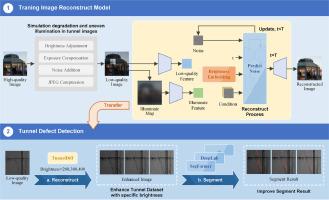TunnelDiff:一种用于提高低质量隧道衬砌图像缺陷检测的亮度引导图像恢复扩散模型
IF 3
3区 工程技术
Q2 ENGINEERING, ELECTRICAL & ELECTRONIC
引用次数: 0
摘要
在隧道中进行捕获时,衬砌材料、照明条件和成像设备等因素可能会影响图像质量并引入噪声。低质量图像给隧道衬砌缺陷检测带来了挑战。本文介绍了TunnelDiff扩散模型,该模型旨在增强隧道图像并更好地进行缺陷检测。TunnelDiff通过利用预训练的稳定扩散模型固有的泛化能力来恢复图像细节。并引入了条件模块来指导生成方向。条件模块包括照明分配模块(IDM)和亮度引导模块(BGM)。IDM专注于纠正隧道图像中的光照不均匀,而BGM则解决低光校正任务中的目标亮度模糊问题。由于隧道增强中缺少配对数据,TunnelDiff首先对暴露误差数据集进行训练,然后对隧道缺陷数据集进行增强。实验结果表明,两种数据集的图像质量指标都有所改善,TunnelDiff增强的隧道缺陷数据集在缺陷检测方面的表现优于其他模型增强的数据集。特别是TunnelDiff在裂纹缺陷检测方面表现更好,裂纹召回率、f1评分和IoU分别提高了2.03%、1.42%和1.55%。此外,TunnelDiff始终在特定的亮度范围内生成图像。这些结果强调了TunnelDiff的有效性。相应的代码可从https://github.com/derolol/tunnel_diff.git获得。本文章由计算机程序翻译,如有差异,请以英文原文为准。

TunnelDiff: A brightness-guided image restoration diffusion model for enhancing defect detection in low-quality tunnel lining images
During capturing in the tunnel, factors such as lining materials, illumination conditions, and imaging equipment may affect the quality of images and introduce noise. The low-quality images bring challenges in tunnel lining defect detection. This paper introduces TunnelDiff, a diffusion model designed to enhance tunnel images and perform better on defect detection. TunnelDiff restores image details by leveraging the inherent generalization ability of the pretrained Stable Diffusion Model. It also introduces the Condition Module to guide the generation direction. The Condition Module includes the Illumination Distribution Module (IDM) and the Brightness Guided Module (BGM). The IDM focuses on correcting uneven illumination in tunnel images, while the BGM addresses target brightness ambiguity in low-light correction tasks. Due to the absence of paired data in tunnel enhancement, TunnelDiff first trained on the Exposure Errors dataset and then enhanced the Tunnel Defect dataset. Experimental outcomes demonstrated improvements in image quality metrics on both datasets, and the Tunnel Defect dataset enhanced by TunnelDiff performed better in defect detection than datasets enhanced by other models. In particular, TunnelDiff showed better crack defect detection, with 2.03 %, 1.42 %, and 1.55 % improvement in crack recall, F1-score, and IoU. Additionally, TunnelDiff consistently produced images within a specific brightness range. These results underscore the effectiveness of TunnelDiff. The corresponding code is available at: https://github.com/derolol/tunnel_diff.git.
求助全文
通过发布文献求助,成功后即可免费获取论文全文。
去求助
来源期刊

Digital Signal Processing
工程技术-工程:电子与电气
CiteScore
5.30
自引率
17.20%
发文量
435
审稿时长
66 days
期刊介绍:
Digital Signal Processing: A Review Journal is one of the oldest and most established journals in the field of signal processing yet it aims to be the most innovative. The Journal invites top quality research articles at the frontiers of research in all aspects of signal processing. Our objective is to provide a platform for the publication of ground-breaking research in signal processing with both academic and industrial appeal.
The journal has a special emphasis on statistical signal processing methodology such as Bayesian signal processing, and encourages articles on emerging applications of signal processing such as:
• big data• machine learning• internet of things• information security• systems biology and computational biology,• financial time series analysis,• autonomous vehicles,• quantum computing,• neuromorphic engineering,• human-computer interaction and intelligent user interfaces,• environmental signal processing,• geophysical signal processing including seismic signal processing,• chemioinformatics and bioinformatics,• audio, visual and performance arts,• disaster management and prevention,• renewable energy,
 求助内容:
求助内容: 应助结果提醒方式:
应助结果提醒方式:


